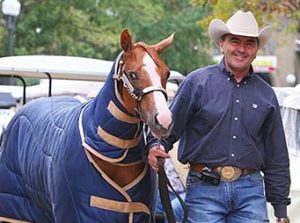To Blanket or Not to Blanket?
Click here to read the complete article170 – May/June 2019
BY TAYLOR FABUS
 Plenty of controversy surrounds the use, or lack thereof, of blankets in the horse industry. Even within the horse show world, many experts are split on how to achieve a show-ready hair coat throughout the year. It’s no secret that no one more successfully maintains a tight hair coat than those who compete in the Halter arena. The Equine Chronicle visited with some of the nation’s leading Halter trainers to learn more about their secrets for maintaining a show-ready hair coat. Read on to discover how Tom Robertson, Buddy Laney, Ted Turner, and Jason Smith combine science, technique, and elbow grease to create a gold trophy winning product.
Plenty of controversy surrounds the use, or lack thereof, of blankets in the horse industry. Even within the horse show world, many experts are split on how to achieve a show-ready hair coat throughout the year. It’s no secret that no one more successfully maintains a tight hair coat than those who compete in the Halter arena. The Equine Chronicle visited with some of the nation’s leading Halter trainers to learn more about their secrets for maintaining a show-ready hair coat. Read on to discover how Tom Robertson, Buddy Laney, Ted Turner, and Jason Smith combine science, technique, and elbow grease to create a gold trophy winning product.
In order to successfully maintain a horse’s hair coat, it’s first important to understand what makes a horse’s hair grow, and shed, throughout the year. Although hair growth generally coincides with colder temperatures, it’s primarily the number of daylight hours that affect a horse’s hair growth, or lack thereof. As the daylight hours slowly start to decrease towards the end of summer and into fall, horses will grow a soft, fuzzy coat over their short, slick summer coat. Likewise, as the daylight hours and temperatures begin to increase in the springtime, the thick, long winter hair starts to shed. It’s actually the horse’s pituitary gland that recognizes this change in daylight hours and subsequently produces hormones that cause a horse to shed its winter coat. With this in mind, the addition of artificial light to a horse’s environment can fool the horse’s pituitary gland into thinking it’s closer to springtime than it is in actuality. This can cause the horse to shed its hair coat earlier than it would naturally. This same philosophy can be applied to bringing mares into heat, as the length of day also has a significant effect on the reproductive status of a mare. The light source should be turned on to supply enough additional light to produce a total of 16 hours of daylight (natural and artificial combined). Perception of day length must be consistent from day to day; the use of automatic timers can make this task easy. Research shows that light intensity should be comparable to one 200-watt bulb for a 12’ x 12’ stall. It will take the horse approximately 60 days before the effects of the light begin to kick in, so this should be taken into account so that lights are added at the appropriate time.
Extremely frigid temperatures affected nearly every part of the country this past winter, and these temperatures presented unique challenges to equine enthusiasts. Nowhere was this more evident than in the Midwest. Located in Southeast Michigan, Tom Robertson Quarter Horses is home to some of the nation’s top Quarter Horse Halter contenders. With many World and Congress Championship titles on his resume, it’s no secret that Robertson has a great deal of experience in getting equine athletes show-ready, no matter the challenging weather that may be thrown his way. “The most important thing in the Halter business is keeping the horses in a consistent routine. We work very hard not to change up their routine, no matter the weather. In the extreme cold that we had this winter, there were a few days that we just exercised to maintain, and we weren’t as hard on them, but anything 10 degrees and up doesn’t bother me. I exercise the horses in a covered round pen that requires us to walk about 50 feet outside to get to it. I’ll walk the horses over in a heavy cooler, the same type we may use at a show, but then as long as it isn’t too bitterly cold, they will all exercise every day. They may only do a light jog in the bitter cold, to be sure that we care for their lungs.” Robertson fondly reminisces, “I can remember growing up in Traverse City, Michigan, and, no matter the weather, I had to run all winter for high school track.”
Click here to read the complete article170 – May/June 2019










